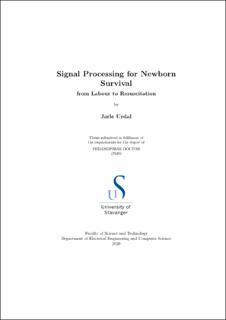| dc.contributor.advisor | Engan, Kjersti | |
| dc.contributor.advisor | Eftestøl, Trygve | |
| dc.contributor.advisor | Ersdal, Hege | |
| dc.contributor.author | Urdal, Jarle | |
| dc.date.accessioned | 2020-08-14T12:54:58Z | |
| dc.date.available | 2020-08-14T12:54:58Z | |
| dc.date.issued | 2020-08 | |
| dc.identifier.citation | Signal Processing for Newborn Survival : from labour to resuscitation by Jarle Urdal, Stavanger : University of Stavanger, 2020 (PhD thesis UiS, no. 535) | en_US |
| dc.identifier.isbn | 978-82-7644-942-6 | |
| dc.identifier.issn | 1890-1387 | |
| dc.identifier.uri | https://hdl.handle.net/11250/2672037 | |
| dc.description | PhD thesis in Information technology | en_US |
| dc.description.abstract | Stillbirths are a worldwide challenge, with an estimated 2.6 million stillbirths in 2015, of these 1.3 million are estimated to have died during labour and birth, i.e. fresh stillbirth. In addition to the 2.6 million, one million newborns die within their first and only day of life. Complications due to birth asphyxia are the primary cause of these deaths. The vast majority, 98%, of stillbirths and early neonatal deaths are found in low resource settings.
This thesis investigates two main challenges related to neonatal deaths, 1) fetal heart rate (FHR) and labour analysis, and 2) improving newborn resuscitation. The FHR is known to be important for effectively assessing the well-being of the fetus during labour. In high resource countries, the FHR is measured using cardiotocography for all high-risk labours. While in low income countries, assessment of the FHR is often done manually using a Pinard. With the use of continuous FHR monitoring in low income countries, abnormalities in FHR could potentially be identified at an earlier stage. In this thesis, we facilitate for further analysis of FHR signals by proposing a method to remove less trustworthy time periods of the measured signal, such as noise. And how missing data can be estimated using dictionary learning to allow for continuous analysis. The FHR signals should be interpreted in combination with the uterine activity. We therefore propose a method for detecting uterine contractions using an accelerometer mounted together with the Doppler ultrasound FHR sensor. Finally, we explore how FHR develops during labour and how this trend differs for labours with a normal and adverse outcomes.
For newborns who are unable to start breathing themselves after birth, immediate help from the healthcare workers are crucial. We therefore explore which parameters during newborn resuscitation are important for the resuscitation outcome. One of the identified parameters is the amount of stimulation, i.e. rubbing the back of the newborn. To get a greater understanding of how stimulation affects newborn resuscitation, and how it should be applied, a large number of annotated resuscitation episodes are required. Manual annotation is both a time consuming and challenging process for the reviewer. We have proposed a complete system for automatically annotating stimulation by using ECG and accelerometer signals measured on the abdomen of the newborn. | en_US |
| dc.language.iso | eng | en_US |
| dc.publisher | University of Stavanger, Norway | en_US |
| dc.relation.ispartofseries | PhD thesis UiS; | |
| dc.relation.ispartofseries | ;535 | |
| dc.relation.haspart | Paper 1: Urdal, J., Engan, K., Eftestøl, T. et al. (2019) Noise and contraction detection using fetal heart rate and accelerometer signals during labour. Scandinavian Health Informatics Conference 2019, SHI 2019. | en_US |
| dc.relation.haspart | Paper 2: Barzideh, F., Urdal, J., Engan, K. et al. (2018) Estimation of Missing data in fetal heart rate signals using shift-invariant dictionary. 26th edition of the European Signal Processing Conference, EUSIPCO 2018. IEEE. | en_US |
| dc.relation.haspart | Paper 3: Urdal, J., Engan, K., Eftestøl, T. et al. Fetal heart rate development during labour. Under review. | en_US |
| dc.relation.haspart | Paper 4: Urdal, J., Engan, K., Eftestøl, T. et al. (2017) Signal processing and classification for identification of clinically important parameters during neonatal resuscitation. Published by the IEEE International Conference on Signal and Image Processing Applications, ICSIPA 2017. | en_US |
| dc.relation.haspart | Paper 5: Urdal, J., Engan, K., Eftestøl, T. et al. (2020) Automatic identification of stimulation activities during newborn resuscitation using ECG and accelerometer signals. Computer Methods and Programs in Biomedicine, 193 | en_US |
| dc.rights | Copyright the author, all right reserved | |
| dc.subject | dødfødsel | en_US |
| dc.subject | fosterlyd | en_US |
| dc.subject | ECG | en_US |
| dc.subject | medisinsk teknologi | en_US |
| dc.subject | fødselshjelp | en_US |
| dc.title | Signal Processing for Newborn Survival : from labour to resuscitation | en_US |
| dc.type | Doctoral thesis | en_US |
| dc.subject.nsi | VDP::Mathematics and natural science: 400::Information and communication science: 420 | en_US |
| dc.subject.nsi | VDP::Teknologi: 500::Medisinsk teknologi: 620 | en_US |
